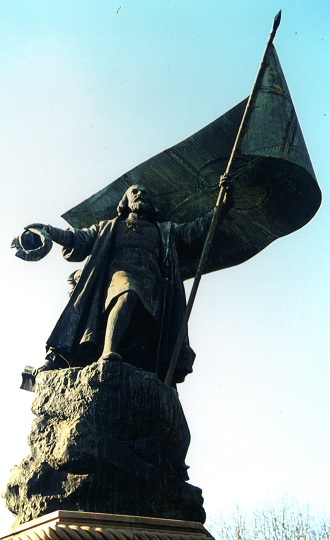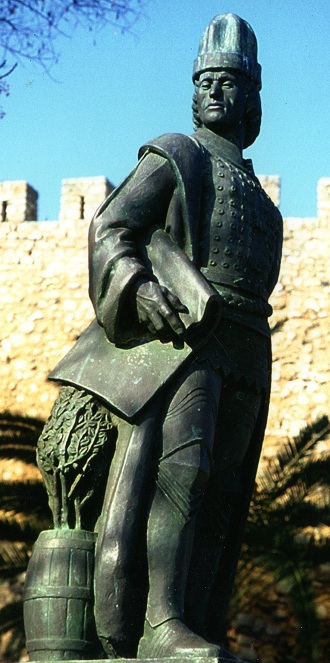
All praise to Amsterdam! The city with the rich past has made it self with one deed into Europe's multi-cultural capital: by opening the European Museum of Overseas Stolen Treasures. In a new, spectacular building, situated halfway Amsterdam's financial district and the international airport Schiphol, the subject is how Europeans throughout the ages accumulated wealth by looting the other continents.
In previous centuries Europeans have been very proud of their war booty, as still can be seen in many museums. But yesterday's war trophies are today's shameful and painful artefacts. The European Museum succeeds wonderfully in overcoming barriers while it tells histories Europeans don't like to hear. Nowadays Europeans are not keen to be reminded of the fact that their working capitals originally were taken by force from the other continents.
The famous question: Is Europe a real community and does it have its own identity? is positively affirmed because museums from all over Europe could contribute overseas stolen cultural goods. The British Museum, the Louvre, the Museum of the Vatican, the Museo de Ameacute;rica in Madrid, the Museum fuuml;r Vouml;lkerkunde in Berlin and many other major and regional museums have been so kind to send important objects from their collections on permanent loan to Amsterdam.
The abstract idea of the origin of the European wealth is made visible and tangible in the narrative of a chronological walk through the halls of the enormous museum. Many of the halls are filled with beautiful objects of exotic art and culture, many objects on display were brought home by European conquerors from battlefields and ruined cities overseas.
It started in mythology with Zeus himself who kidnapped Europe from Phoenicia. Alexander the Great in c. 330 BCE took enormous treasures from Egypt and Persia. Flavius Titus sacked the Temple in Jerusalem in 70 CE and came home in a lavish parade containing treasures and slaves, as still can be seen on the Triumphal Arch of Titus in Rome. A replica of the Arch is erected in the European Museum in Amsterdam.
In 828 the Venetians Buono da Malamocco en Rustico da Torcello stole the human remains of the saint and evangelist Marc from Alexandria: the arrival of the holy relic was the beginning of Venice as a centre of European riches. In a magnificent mosaic in the San Marco in Venice the famous robbers are still being honored today.Ample space is given to the crusaders in Jerusalem (1099) and Constantinople (1203), Corteacute;s in Mexico (1519), Pizarro in Peru (1532) and Sir Francis Drake in the Pacific (1580).

In the European Museum is shown how the citizens of Europe are surrounded by signs and proof of the Robbers' Paradise of their forefathers in the other parts of the world. The facts Europeans don't like to acknowledge are staring them in the face everywhere. Precisely what Europeans collectively like to deny, is in all European countries on display in the museums and even in the streets. For example in Portugal.
The monument for Pedro Aacute;lvares Cabral in Lisbon is a bronze copy of a monument in Rio de Janeiro. The government of Brazil presented it in 1940 to the former motherland. The sculptor Rudolfo Bernardelli (1852-1931) changed his nationality into Brazilian and he has expressed in this monument an essential feature of European colonialism. On a high pedestal near the entrance of a park the larger than life admiral is the first European toland in Brazil. Seen from the front the monument seems to represent one person: a polite gentleman, waving his hat. But his crusader's flag is attached to a weapon. And hidden behind his back two other man - the padre and the colonist - follow in his shadow.
Portuguese national hero Gil Eanes, the first European who sailed beyond the Sahara, looks out over the harbour of Lagos, Portugal. And behind his back he is holding quite a sword. Already the Chanson de Roland taught Europeans that a Christian is not obliged to keep his word of honour against a heathen. In this light Gil Eanes' statue of the man with a sword behind his back seems a visual summing-up or emblematic figure of the Europeans overseas.
The European Museum puts the spotlight not only on the robbers, but also on their critics. Prominent among the critics are Bartolomeacute; de Las Casas (1484-1566) and Michel de Montaigne (1533-1592).
Like many other cultures European culture is built upon plunder and slavery, but only the Europeans have developed a critical tradition. For instance: many cultures have known the institution of slavery, but only Europeans have developed an anti-slavery movement which in the end was successful.